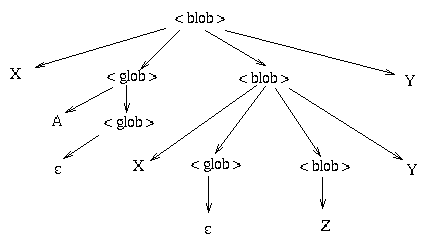| Parse Trees and Ambiguity |
| < blob > |
 x < glob > < blob > y
x < glob > < blob > y | ||||||||||||||||||||||||||||||||||||||||||||||||||||||||||||||||||||||||||||||||||||||||||||||||||
| < blob > |
 z
z | ||||||||||||||||||||||||||||||||||||||||||||||||||||||||||||||||||||||||||||||||||||||||||||||||||
| < glob > |
 a < glob >
a < glob > | ||||||||||||||||||||||||||||||||||||||||||||||||||||||||||||||||||||||||||||||||||||||||||||||||||
| < glob > |
 eps
eps
| ||||||||||||||||||||||||||||||||||||||||||||||||||||||||||||||||||||||||||||||||||||||||||||||||||
 xaxzyy since:
xaxzyy since:
 x < glob > < blob > y
x < glob > < blob > y
 x a < glob > < blob > y
x a < glob > < blob > y
 x a < blob > y
x a < blob > y
 x a x < glob > < blob > y y
x a x < glob > < blob > y y
 x a x < blob > y y
x a x < blob > y y
 x a x z y y
x a x z y y
 x < glob > < blob > y
x < glob > < blob > y
 x < glob > x < glob > < blob > y y
x < glob > x < glob > < blob > y y
 x < glob > x < blob > y y
x < glob > x < blob > y y
 x < glob > x z y y
x < glob > x z y y
 x a < glob > x z y y
x a < glob > x z y y
 x a x z y y
x a x z y y


 P and
P and  is the
string of labels found on the node N's children.
is the
string of labels found on the node N's children.

| < stmt > |

| if < expr > then < stmt > | ||||||||||||||||||||||||||||||||||||||||||||||||||||||||||||||||||||||||||||||||||||||||||||||||||
| | | if < expr > then < stmt > else < stmt > | |||||||||||||||||||||||||||||||||||||||||||||||||||||||||||||||||||||||||||||||||||||||||||||||||||
| Parse Trees and Ambiguity |